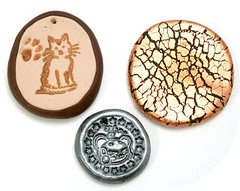We once learned how to make carvings in linoleum blocks for printing in art class at school. I doubt I was really good at it, but it was fun. Didn't cut my fingers off, at least. It is, however, nothing I've dabbled in since. But then, some time last year I bought a set of knives (for carving in linoleum and soft wood) and a square of linoleum substitute.
This time I wasn't looking to carve printing blocks, but rather texture plates and stamps. I started out making raised motifs as that's easier: you just carve the parts that will be raised unlike when making stamps and you have to carve around every little dot and hair-thin line. I'm also thinking of trying to carve wood, but it'll have to wait. Focus right now is textures and motifs for imprinting clay. There's some forgotten poly clay that needs to be used soon.
At first I didn't want to start carving as I was afraid of ruining the square. It's not big so there aren't much room for carving and so I didn't want to mess up and have to buy a new one. Then I got an urge to just carve something. Didn't have a pen that worked on the greasy, plastic surface so instead I doodled and worked on freehand. As long as I stuck to simple flowers and leaves/grass straws it wouldn't be too hard to succeed with. They might not be amazingly good, but they are decent -- especially considering I haven't carved anything in the last 18 years and when I did carve in school it was just a couple of printing plates before we moved on to the next technique.
This is one of my more expensive types of doodling as you can't reuse the linoleum once it's cut. With photo editing, I don't run out of material. With drawn doodles, it takes a long time to run out of pen/pencil and paper. And in both cases you can -- in some amount -- erase mistakes in a way you can't do when carving. So I won't carve that much, it'll be too expensive to keep buying something to carve in. But it's fun so this won't be my last carvings.
The carvings look pretty boring photographed as there's no colours and no sense of scale so first I'll be showing a few pics taken in "artistic" angles.
Very simple and not exactly meticulous carvings, but I hope that with some colour and a nice shape of the bead or pendant, they'll look nice. Some carvings are a tad shallow, but I'm hoping it'll be enough.
Apart from the flower meadow, I made a few small motifs and a hideous texture that I can just hope will turn out ok once printed in clay and painted.
I also wondered what it'd be like to carve a word or two. Started by writing Ullegull's name and soon realised this would look very... special. Even if I had written out the name to follow, it turned out I had written it slightly too small and too condensed.
Then, thinking about my recent rune doodles, I thought runic script would be better for this than the latin alphabet. After all, runes were designed to be easy to carve into wood. And the result? Well, I still have to practice. Most of all, I learned how important it is to plan the cuts. When you write, you usually draw the main stave first and then the shorter lines and there's no problem, but when carving it turned out to be troublesome to cut the diagonal staves on the N and A runes as I got stuck in the groove of the already cut stave. Next time I'll try cutting the shorter lines first and see if that helps.
And here's what it looks like printed in Tack-It. Not as horrible as it might look judging from the photo above, but still a lot of room for improvement.
I'll fill the square with some more carved doodles, but then I should try and make an effort to get out the clay and use the texture plate for something more than just Tack-It. Clay isn't my best medium, but some day I hope to master it a bit better -- though I would like to work with epoxy clays rather than polymer in the future as there's no hassle with oven baking. Anyway, fingers crossed I'll be able to show a finished piece soon so you can see the result of these doodling sessions of mine.

.JPG)












